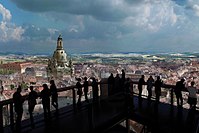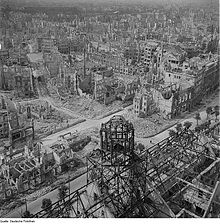Panometer Dresden
| Panometer Dresden | |

|
|
|---|---|
| Panometer in Dresden | |
| Location data | |
| State : | Germany |
| Region : | Saxony |
| City : | Dresden |
The Panometer Dresden is a former gasometer (gas container) in Dresden , in which various panorama pictures by the artist Yadegar Asisi have been exhibited since 2006 .
From 2006 to 2011 and after a revision from 2012 to 2014, the picture with the original name 1756 Dresden could be seen, which shows the Saxon state capital at the time of the Dresden Baroque . In 2012, the work Rome 312 was exhibited, which had previously been shown in the Panometer Leipzig . On the occasion of the 70th anniversary of the air raids on Dresden , a panorama of the destroyed city was presented in the first half of 2015. Since the middle of 2015, the panoramas Dresden in Baroque and Dresden 1945 have been shown alternately.
The term panometer is a word created by Yadegar Asisis and is a suitcase word from panorama and gasometer.
Location
The Dresden Panometer is located on Gasanstaltstraße at the northern end of the Reick district in the former Dresden gas works . It is within sight of the Děčín – Dresden railway line . Due to their structural requirements, such as a round structure and a large, empty interior, gasometers are very suitable as an exhibition space for large panoramic images.
photos
Both gasometers in Reick - the panometer in front
Exhibitions

In the Panometer Leipzig , Yadegar Asisi was already successful with his projects 8848Everest360 ° (2003 to 2005) and since 2005 with Rom CCCXII when, after several years of research, he created a panorama picture of Dresden in 1756, before the outbreak of the Seven Years War . So-called vedute , i.e. realistic, historical representations - especially by Bernardo Bellotto , called “Canaletto” - served as the basis . The Panometer was opened on December 9, 2006. 250 years after the end of Dresden's baroque heyday, the city's 800th anniversary was the occasion. In the first two years of its existence, more than 500,000 visitors were recorded.
"1756 Dresden" (2006 to 2011)
Until 2011 the 360-degree panorama painting 1756 Dresden was exhibited in the gasometer . It was located on the inner wall and could from an elevated, central location in perspective be considered correct. It was then revised. The picture is 27 meters high, has a circumference of 105 meters and shows the objects depicted in the perspective size in which you would actually see them. The given view gives a largely historical, partly artistically freely interpreted view from the tower of the Catholic Court Church of Dresden during the baroque period . Eric Babak composed the accompanying soundtrack .
In a supporting exhibition, in the tour between the panorama picture and the gasometer outer wall, information about the creation of the painting and the origin of the historical cityscape of Dresden could be seen. Historical city maps and original illustrations from the 18th and 19th centuries were also exhibited. For example, the bell of the Neustadt town hall and facade decorations of Dresden buildings that have since been destroyed were presented. Some views of the historical cityscape that were painted during the creation of the panorama of Asisi were also shown.
"Rome 312" (2011 to 2012)
Rom 312 or Rom CCCXII is the title of the panorama painting that was on view in the Panometer Dresden until November 8, 2012. The painting, which is based on a panoramic view from the 19th century by Josef Bühlmann and Alexander von Wagner, showed the intake of Constantine the Great and his soldiers in 312. Chr. In Rome after when he Battle of the Milvian Bridge his Maxentius had eliminated competitors . The circular painting was the only comprehensive representation of ancient Rome on a 1: 1 scale.
"Dresden - Myth of the Baroque Residence City" (2012 to 2014)
As a result of the revision of the Panorama 1756 Dresden , the picture Dresden - Myth of the baroque royal seat could be seen from December 1, 2012 until the end of 2014 .
"Dresden 1945: Tragedy and Hope of a European City" (2015)
From January 24th to May 31st, 2015, the panorama of Dresden was opened for the first time after the destruction on the 13th and 14th. Shown February 1945 .
Alternating since 2015
The panorama of the destroyed Dresden is shown for a few months around the anniversary of the attack, alternating with the panorama of baroque Dresden.
"Dresden in Baroque - Myth of the Saxon Residence City"
Yadegar Asisi presents city life and everyday life at the Dresden court in the Augustan era in the 360 ° panorama . The Saxon metropolis can be seen in the prime of its baroque architectural splendor. The view wanders from the tower of the Catholic Court Church over the densely built-up alleys, squares and the individual courtyards of the Residenzschloss to the Zwinger , over the Frauenkirche and the (old) Kreuzkirche , palaces such as the Brühlschen glories or the Japanese Palace on the other bank of the Elbe up to Direction Meißen in the north-west or Pillnitz in the south-east - a cityscape of Renaissance and Baroque architecture, whose backdrop, seen from the Neustadt side, still shapes the image of Dresden today despite the destruction in 1945. ( Canaletto view )
"I believe that a look at the urban structures of different epochs in human history reveals a lot about the culture of togetherness and demarcation, about rich and poor, about humanity and inhumanity, about love and hate." (Yadegar Asisi)
"Dresden 1945 - Tragedy and Hope of a European City"
The approximately 3,000 m² panorama Dresden 1945 shows the destroyed city immediately after the Allied bombings in February 1945. The viewer experiences the extent of the destruction from the town hall tower in the old town. Heavy billows of smoke lie over the scenery and individual fires illuminate the apocalyptic landscape of ruins. The project was developed in close professional exchange with the Military History Museum of the Bundeswehr in Dresden. Eric Babak again designed the corresponding soundscape and thus complements the spatial impression in the panorama.
“ Dresden 1945 is my contribution to reflect on the creative power and the abysses of man, on the cruel logic and the madness of war in the world. Dresden stands for the tragedy and the hope of a city in Europe that will be extinguished in just a few moments. I hope that the panorama will contribute to the culture of remembrance in Dresden. ”(Yadegar Asisi)
Dresden 1945 not only puts Dresden's victim situation in the foreground, but also draws attention to a broader context: the internal destruction of Dresden, the annihilation of countless human lives and, from 1939 onwards, numerous cities in Europe had already begun when the National Socialists came to power in 1933. For example, Rotterdam , Coventry , Stalingrad and Warsaw were destroyed by German attacks . Dresden 1945 also pays tribute to the achievements of the reconstruction, but also questions urban planning concepts of the post-war period. After 1945 a radical renovation of the area was carried out, which finally fell victim to numerous burned-out monuments such as the Sophienkirche or the Albert Theater .
literature
- Yadegar Asisi (ed.), Rhoda Riccius: ROM CCCXII. The largest panorama in the world in the Leipzig Panometer. Panometer, Leipzig 2006, ISBN 978-3-00-018855-8 .
- Yadegar Asisi, Marina Rütten (staff): Architect of illusions. Faber & Faber, Leipzig 2004, ISBN 3-936618-43-7 .
- Stefan Hertzig, Nadine Herwerth (Ed.): 1756 - the baroque Dresden. A project by the Asisi Factory. Asisi Factory, Berlin 2007, ISBN 978-3-00-020876-8 .
Web links
Individual evidence
- ^ Panorama artist Asisi plans a panorama of destroyed Dresden. DNN online, January 14, 2014.
- ↑ MDR: Asisi collects recordings from the destroyed Dresden. April 18, 2014 ( Memento from October 19, 2014 in the Internet Archive )
- ↑ Asisi blog: photo call for Panorama Dresden finished 1945th May 28, 2014 ( Memento from December 20, 2014 in the Internet Archive )
Coordinates: 51 ° 1 ′ 32 ″ N , 13 ° 47 ′ 18 ″ E





